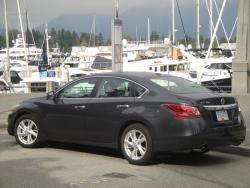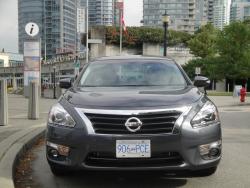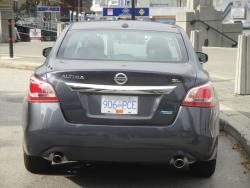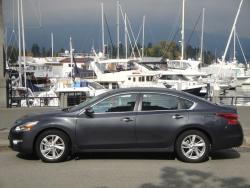 2013 Nissan Altima 2.5 SL sedan. Click image to enlarge |
|
First Drive: 2013 Nissan Altima
Manufacturer’s web site |
Review and photos by Greg Wilson
Photo Gallery:
2013 Nissan Altima
Mr. Spock (you know, the pointy eared Vulcan from the Star Trek series) would love the new Nissan Altima. Everything about it is so eminently practical and logical. Equipped with the base 2.5-litre four-cylinder engine and standard continuously variable transmission, it’s quiet, easy to drive, gets good fuel economy, has a comfortable ride, a roomy cabin with comfortable seats, and a big trunk—and it has a Five-Star crash safety rating from the NHTSA. The new Altima is such a sensible car that there’s really no logical reason why you shouldn’t like it—if you’re a Vulcan.
But as a human, I like my ride to excite me, at least a little bit—even if it’s a family sedan. The redesigned 2013 Altima 2.5 SL didn’t do that for me, despite having sleeker styling, adequate power, decent handling and many of the latest technological and safety features. To put it simply, the 2013 Altima 2.5 is designed for drivers and passengers who want comfort and practicality first and aren’t too concerned about its 0 to 100 km/h time, lateral g’s, and steering responsiveness.
   2013 Nissan Altima 2.5 SL sedan. Click image to enlarge |
However, the four-cylinder Altima 2.5 is exciting in other ways. It excels when it comes to passenger comfort, starting with a comfortable ride provided by a compliant fully independent suspension (retuned multi-links at the rear for 2013), a roomy cabin with generous rear legroom, and exceptionally comfortable seats. The driver’s seat, in particular, provides excellent back and seat support and includes power adjustable lumbar, power seat cushion tilt, power seat height adjustment, and power fore-aft and recline functions. The front passenger seat is also very comfortable even without those power adjustments—which proves to me that the seats themselves are well designed. In the SL trim, both front seats have High/Low seat heaters and there’s a heated steering wheel. At the rear, the outboard seats (often less comfortable than the front seats) are also surprisingly comfortable, helped in part by the Altima’s abundant rear legroom and generous headroom.
For 2013, the revised four-cylinder engine and continuously variable transmission pair up to keep engine revs as low as possible to aid fuel economy and reduce noise. The standard 2.5L DOHC four-cylinder engine is lighter and more fuel-efficient than the 2012 engine, and gets a small bump in horsepower to 182 from 175 while torque remains the same at 180 lb-ft. It now includes variable valve timing on both intake and exhaust camshafts and a retuned intake system for a flatter torque curve. Combined with a revised continuously variable transmission with fewer moving parts, the four-cylinder Altima is rated at 7.4 L/100 km (city), 5.0 L/100 km (hwy). That’s a considerable improvement over the 2012 Altima 2.5 CVT with 8.7/6.0 city/hwy. By the way, last year’s standard six-speed manual transmission is no longer offered.
On the road, you can hardly hear the Altima’s four-cylinder engine while cruising or idling in traffic. Under acceleration, the engine emits a deep growling sound as the CVT maintains constant revs, but the engine doesn’t drone on too much unless you really put the pedal to the floor. The CVT’s tall final drive ratio provides quiet running at highway speeds: the engine revs at just 1,600 rpm at a steady 100 km/h. Perhaps due to the quiet engine and CVT, tire and wind noise seems more pronounced, but it’s hard to tell whether that’s just because the engine is quiet.
    2013 Nissan Altima 2.5 SL sedan. Click image to enlarge |
Performance can be enhanced by selecting Drive Sport (DS) on the shift gate. Pull the shift lever down a notch into DS and the throttle response becomes more immediate and the engine revs higher for faster acceleration. Still, when cruising on the freeway, I found that engine revs are about the same in D or DS modes. I tended to leave the transmission in DS mode when I was in a hurry, but otherwise it’s unnecessary and no doubt increases fuel consumption. As well, there’s a button on the side of the shift lever that acts like an overdrive-off button to quickly increase revs for immediate acceleration. But unlike some CVTs, this shifter has no manual shift option.
Though the Altima 2.5 emphasizes ride quality over handling, it does have a fully independent suspension consisting of front struts and rear multi-links. For 2013, the rear suspension features improved camber angle control for better tire contact when cornering and new shocks for better body control. As well, the new Altima has a wider track for increased stability (+36 mm) and features an electronic Active Understeer Control (AUC) system which automatically brakes the inside front wheel during cornering to reduce ‘plowing’ or understeer. It’s not an emergency system like electronic stability control—AUC works constantly to improve handling in everyday driving. Nissan claims it reduces stress in driving, which in its own way, contributes to the Altima’s comfortable ride.
The Altima’s steering feel is not as responsive or as quick as in some other mid-size sedans, such as the Accord and Sonata, but it’s not overboosted either. An 11.4-m (37.5 ft.) turning diameter is decent enough for a mid-size, front-drive sedan.
The driving position is very good. The Altima’s multi-adjustable driver’s seat and tilt/telescopic steering wheel will help most drivers find an ideal driving position, and rear visibility is assisted by a small third side window and a rear-view camera that displays an image in the touchscreen. This image can be switched between a wide-angle view and a longer view and yellow and red marker lines indicate where the driver should stop when backing up. My only complaint is that the screen resolution is not as sharp as other screens I’ve seen, and I was disappointed there were no rear parking sensors in the top Altima SL trim.
The 2013 Altima 2.5 does include some noteworthy new safety features, but they’re only available in the SL trim as part of the optional Technology Package ($1,100). A blind spot warning system activates small warning lights near the side mirrors to alert the driver when another vehicle is travelling in the left or right blind spots—if the driver moves into the next lane, a warning beep will sound. As well, a lane departure warning system emits a beeping sound if the car veers over the line, and a moving object detection system alerts the driver to cross traffic behind the vehicle when in Reverse gear. I especially liked the blind spot warning lights, which really help the driver to be aware of cars hidden in the blind spots. As before, all Altimas include anti-lock brakes, traction control, electronic stability control and a tire pressure monitoring system.
     2013 Nissan Altima 2.5 SL sedan. Click image to enlarge |
Though the 2013 Altima has the same wheelbase as the 2012 model, the body is about 34 mm wider, which makes the cabin seem more spacious. The quality of the interior materials has moved up a notch and includes leather seats and trim (SL), a soft padded dash, attractive carbon-fibre like trim around the shift lever and door handles, and appropriately placed silver and chrome accents. I liked the bright, illuminated white-on-black gauges and small digital trip computer and information screen between them. The driver can scroll through useful information like average fuel economy, driving distance, average speed, trip timer, and radio station. There’s also an odometer, transmission gear indicator, outside temperature, and distance-to-empty indicators.
The optional centre seven-inch touchscreen (five inches in SV trim) is used for audio, navigation, telephone, and information functions and can be controlled using dash buttons, steering wheel controls or voice activation. If you don’t know the proper voice command, a female voice will give you a selection to choose from, making it easy to use if you haven’t read the owner’s manual. As well, Nissan’s navigation system offers unique features such as real-time traffic and weather information, flight information, local fuel prices, points of interest powered by Google search, and text to speech messages. These latter features are only accessible to the registered owner of the car, so I wasn’t able to try them out—except the traffic info, which alerted me to some closed exit ramps in my area. My primary concern with the touchscreen was the glare on the screen that rendered it unreadable at times.
Smartphones and iPods can be connected to a USB port and a 12-volt charger inside a covered bin at the bottom of the centre console, and there’s also a 12-volt outlet inside the centre storage bin under the padded armrest. The audio system also supports wireless Bluetooth audio. The nine-speaker Bose audio system that’s standard in the Altima SL provides clear, dynamic sound quality and includes AM, FM, CD, XM satellite radio, Pandora internet radio, and AUX and Bluetooth.
The Altima’s large 436 L (15.4 cu. ft.) trunk is fully lined and the trunk lid can be opened remotely. Standard 60/40 split folding seatbacks provide the ability to carry longer objects, but the seatback opening between the two rear wheel wells is rather narrow.
The Altima’s keyless ignition is a real time-saver: with the ignition key fob in your pocket, you can lock and unlock the driver and passenger doors simply by pressing a button on the door handle. Once inside, a keyless push-button ignition allows the car to be started and stopped without taking the key out of your pocket or purse.
Nissan prices the 2013 Altima as follows: Altima 2.5 – $23,698; 2.5S – $24,898; 2.5SV – $26,998; 2.5SL – $29,598; 3.5SV – $29,698; 3.5SL – $32,598.
Like the previous Altima, the new model is assembled in Canton, Mississippi and its engines are built in Decherd, Tennessee.
Pricing: 2013 Nissan Altima 2.5 SV
Base price: $29,598
Options: $ 1,235 (Technology Package $1,100: navigation system with 7-inch touch-screen and voice recognition; NavTraffic; Points of Interest powered by Google, Google send to car, fuel, flight and weather information; Blind Spot Warning; Moving Object Detection; Lane Departure Warning. Metallic Slate paint $135)
Freight & PDI: $1,695
A/c tax: $100
Price as tested: $32,628
Competitors
Buick Regal
Chevrolet Malibu
Chrysler 200
Dodge Avenger
Ford Fusion
Honda Accord
Hyundai Sonata
Kia Optima
Mazda6
Subaru Legacy
Toyota Camry
VW Passat











